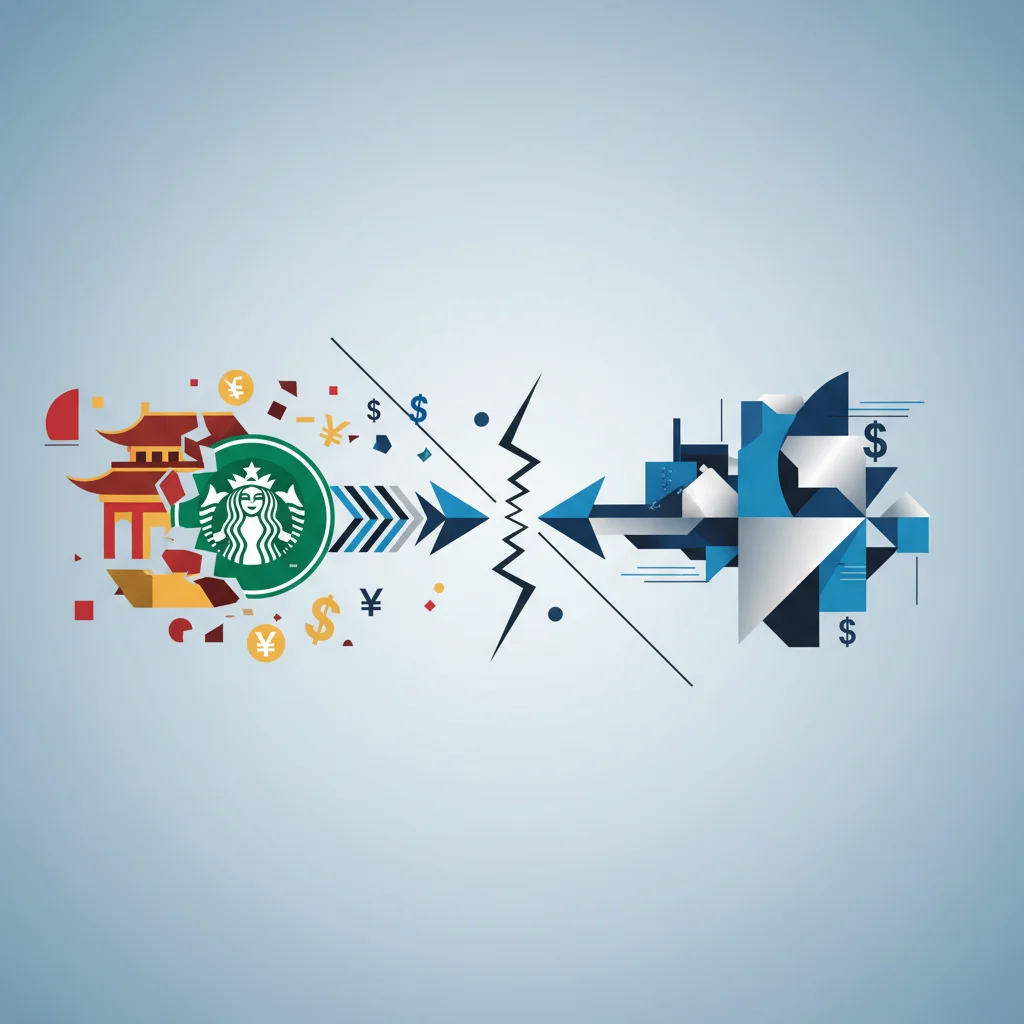
The Great China Cash-Out: Deconstructing Starbucks’ $4 Billion Strategic Pivot
In a move sending ripples through the global business and finance communities, Starbucks has announced its intention to sell a majority stake in its China operations in a landmark deal valued at approximately $4 billion. For a company that once heralded China as its most crucial growth engine, this decision marks a dramatic strategic pivot. After more than a quarter-century of brewing success and cultivating a coffee culture in a nation of tea drinkers, the Seattle-based giant is fundamentally altering its relationship with its second-largest market. This isn’t just a financial transaction; it’s a commentary on the shifting tides of global economics, fierce local competition, and the evolving calculus of risk and reward for multinational corporations.
For investors, business leaders, and anyone tracking the pulse of the global economy, this move raises critical questions. Why would Starbucks relinquish majority control of a business it spent decades building? What does this signal about the future of Western brands in China? And where does the coffee titan go from here? This analysis will delve into the historical context, competitive pressures, and financial implications of this multi-billion-dollar decision, offering a comprehensive perspective on a deal that will be studied in business schools for years to come.
A Tale of Two Decades: Starbucks’ Rise as a Chinese Status Symbol
To understand the magnitude of this sale, one must first appreciate the scale of Starbucks’ success in China. When the company opened its first store in Beijing in 1999, the concept of paying a premium for a cup of coffee was entirely foreign. Starbucks didn’t just sell coffee; it sold an experience. It introduced the “third place”—a comfortable, aspirational space between home and work where China’s burgeoning middle class could signal their sophistication and global outlook.
For two decades, the strategy was an unmitigated triumph. The company embarked on one of the most aggressive retail expansions in history, at one point opening a new store in China every 15 hours. This rapid growth was a cornerstone of the company’s narrative for Wall Street, promising a seemingly endless runway in a market of 1.4 billion people. The China business became a crown jewel, a testament to the power of a Western brand to successfully integrate into a complex and culturally distinct market. This success was reflected in the stock market, where SBUX’s China growth story often fueled investor optimism and drove valuations higher.
Petrofac's Perfect Storm: A Deep Dive into Corporate Collapse and the Future of Energy Finance
The Dragon’s Awakening: How Local Competition Rewrote the Rules
No reign lasts forever. The very market Starbucks cultivated eventually gave rise to its fiercest competitors. The primary antagonist in this story is Luckin Coffee, a tech-driven upstart that challenged Starbucks on every front. While Starbucks sold a premium “third place” experience, Luckin built a business model for a new generation of Chinese consumers: digital-native, convenience-obsessed, and price-sensitive.
Luckin’s strategy was a masterclass in market disruption, leveraging aggressive financial technology through its app-first model. It focused on small, kiosk-style locations for rapid pickup and delivery, slashing overhead and passing the savings to customers. Heavy discounting and a seamless digital experience quickly eroded Starbucks’ market share. Despite a major accounting scandal in 2020 that led to its delisting from the Nasdaq, Luckin Coffee mounted a remarkable comeback and, by 2023, had surpassed Starbucks in store count within China (source). This relentless pressure fundamentally changed the competitive landscape.
Below is a comparison of the two rivals’ operating models, highlighting the strategic differences that defined this coffee war:
| Feature | Starbucks China | Luckin Coffee |
|---|---|---|
| Business Model | Premium “Third Place” Experience | Tech-driven, “Grab-and-Go” Convenience |
| Pricing Strategy | Premium | Value-oriented, heavy discounting |
| Primary Interface | In-store experience, supplemented by app | Mobile app is central to all orders |
| Store Format | Large, comfortable cafes with seating | Small pickup kiosks and delivery kitchens |
| Target Audience | Affluent middle-class, social gatherings, business meetings | Young professionals, students, daily coffee drinkers |
Macro Headwinds: A Shifting Economic and Political Climate
The competitive threat from Luckin and other local players like Cotti Coffee was amplified by a cooling Chinese economy. After decades of explosive growth, China has entered a period of slower expansion, grappling with a property crisis, high youth unemployment, and flagging consumer confidence. In this environment, the aspirational spending that once buoyed Starbucks has given way to a more cautious, value-driven mindset. Chinese consumers are increasingly “trading down,” making Luckin’s affordable offerings more appealing than ever.
Furthermore, geopolitical tensions between the U.S. and China have created a more challenging operating environment for American firms. A rising tide of nationalism has also fueled a “guochao” trend, where consumers show a growing preference for domestic brands. According to a 2023 report by consulting firm Bain & Company, local brands are now growing faster than their foreign counterparts in many consumer categories in China (source). For Starbucks, this meant swimming against a powerful cultural and economic current.
Solving the Financial Puzzle: Why Today's Economy is the Ultimate Crossword
Unpacking the Deal: Financial Implications and Future Strategy
The finance behind this $4 billion deal is as important as the strategy. Selling a majority stake allows Starbucks to unlock a tremendous amount of capital from its balance sheet. This infusion of cash provides significant flexibility and firepower for the company’s global operations. The key question for those involved in investing and trading SBUX stock is: what will they do with the money?
Several strategic avenues are likely:
- Accelerated Investment in the U.S. Market: The U.S. remains Starbucks’ largest and most profitable market. The capital could fund the “Triple Shot Reinvention” strategy, which includes store remodels, new equipment to improve efficiency, and wage increases to attract and retain talent.
- Expansion in Other High-Growth Markets: With China becoming more challenging, Starbucks can redirect its focus to other promising emerging markets like India, Southeast Asia, and Latin America, where a growing middle class presents new opportunities.
- Technological Advancement: Starbucks has always been a leader in blending retail with digital. This capital could fuel a new wave of innovation. We might see significant investment in fintech to enhance its loyalty program and mobile payment systems, which are already models in the industry. There’s even potential for exploring emerging technologies like blockchain to offer radical transparency in its “bean-to-cup” supply chain, reinforcing its premium and ethical sourcing claims to an increasingly conscious consumer base.
- Shareholder Returns: A portion of the proceeds will almost certainly be returned to shareholders through increased dividends or stock buybacks, a common move to support the stock price after a major divestiture. Major investment banking firms will likely advise on the optimal capital allocation strategy.
This strategic shift reflects a broader trend in global economics, where multinational corporations are moving from a model of full ownership in foreign markets to more flexible partnership and licensing structures. This approach mitigates risk while still allowing the brand to profit from its intellectual property and global recognition.
Anatomy of a Downfall: Petrofac's Collapse and the Hard Lessons for Investors and the Economy
Conclusion: A New Chapter for a Global Icon
Starbucks’ decision to sell a majority stake in its China business is a watershed moment. It signifies the end of an era of unfettered growth for Western brands in the country and the beginning of a new, more complex chapter defined by local competition and economic realism. This is not a story of failure, but one of adaptation. By cashing in on two decades of brand-building, Starbucks is executing a pragmatic pivot, securing a massive financial gain and freeing up resources to pursue growth elsewhere.
For the financial world, this move offers a powerful case study in strategic capital allocation and risk management. It underscores the dynamic nature of global markets and the necessity for even the most iconic brands to evolve. As Starbucks pours its $4 billion windfall into new ventures, technology, and core markets, the next chapter in its story is just beginning to brew. Investors and business leaders will be watching closely to see if this great China cash-out will fuel another generation of global growth.


